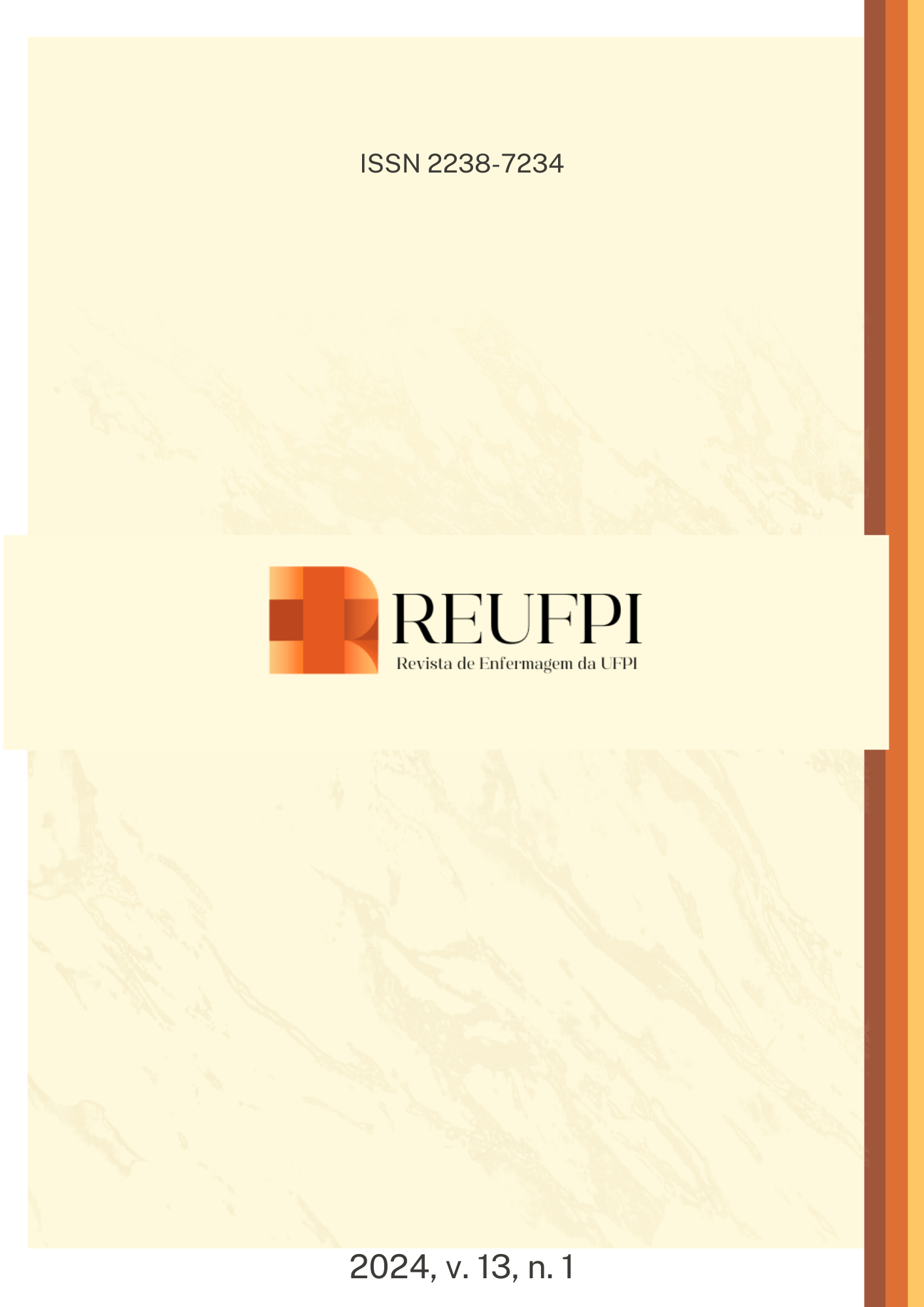Nursing diagnoses in critically ill patients during the COVID-19 pandemic
DOI:
https://doi.org/10.26694/reufpi.v13i1.5552Palavras-chave:
COVID-19, Cuidados críticos, Diagnóstico de enfermagemResumo
Objective: To verify the association between NANDA International nursing diagnoses and their elements in critically ill patients during the COVID-19 pandemic. Methods: Descriptive study that analyzed 60 medical records of patients admitted to the reference intensive care unit for COVID-19 in Pernambuco between August and October 2020. The data was analyzed using descriptive and inferential statistics. The study was approved by the ethics committee under number: 4.199.128. Results: The diagnosis “Ineffective airway clearance” was associated with the element “infection”, while “Deficit in self-care for dressing” was associated with all its defining characteristics and the related factors: “Discomfort” and “Pain”. “Risk of aspiration” was associated with the elements: ineffective coughing, enteral feeding, impaired ability to swallow, decreased level of consciousness and the presence of a nasal/oral tube. Altered skin characteristics, edema, diabetes mellitus and hypertension were associated with “Ineffective peripheral tissue perfusion”. “Dysfunctional response to ventilatory weaning” was associated with nine of its elements. Conclusion: There were associations between five NANDA International nursing diagnoses and their elements in critically ill patients during the COVID-19 pandemic. This enables the implementation of qualified care focused on the real needs of patients.
Referências
Ministério da Saúde (BR). Protocolo de manejo clínico da Covid-19 na Atenção Especializada. Brasília (DF): Ministério da Saúde; 2020.
Bouadma L, Lescure FX, Lucet JC, Yazdanpanah Y, Timsit JF. Severe SARS-CoV-2 infections: practical considerations and management strategy for intensivists. Intensive Care Med. 2020;46(4):579–82. DOI: 10.1007/s00134-020-05967-x.
Majumder J, Minko T. Recent Developments on Therapeutic and Diagnostic Approaches for COVID-19. AAPS J. 2021;23(1):14. DOI: 10.1208/s12248-020-00532-2.
Marian AJ. Current state of vaccine development and targeted therapies for COVID-19: impact of basic science discoveries. Cardiovasc Pathol. 2021;50:107278. DOI: 10.1016/j.carpath.2020.107278.
Yuan L, Chen S, Xu Y. Donning and doffing of personal protective equipment protocol and key points of nursing care for patients with COVID-19 in ICU. Stroke Vasc Neurol. 2020;5(3):302–307. DOI: 10.1136/svn-2020-000456.
Herdman TH, Kamitsuru S, Lopes C, editors. Nanda International Nursing Diagnoses: Definitions & Classification 2021-2023. New York: Thieme Medical Publishers; 2021.
Rede de Pesquisa em Processo de Enfermagem (BR). Diagnósticos, Resultados e Intervenções de enfermagem para atendimento aos pacientes com COVID-19 em estado crítico durante a pandemia da covid-19: Versão 2. Brasil (BR): Rede de Pesquisa em Processo de Enfermagem; 2020.
Alhazzani W, Møller MH, Arabi YM, Loeb M, Gong MN, Fan E, et al. Surviving Sepsis Campaign: guidelines on the management of critically ill adults with Coronavirus Disease 2019 (COVID-19). Intensive Care Med. 2020;46(5):854–887. DOI: 10.1007/s00134-020-06022-5.
Barros A, Silva V, Santana RF, Cavalcante A, Vitor AF, Lucena AF, et al. Brazilian Nursing Process Research Network contributions for assistance in the COVID-19 pandemic. Rev Bras Enferm. 2020;73(2):e20200798. DOI: 10.1590/0034-7167-2020-0798.
D'Adamo H, Yoshikawa T, Ouslander JG. Coronavirus Disease 2019 in Geriatrics and Long-Term Care: The ABCDs of COVID-19. J Am Geriatr Soc. 2020;68(5):912–917. DOI: 10.1111/jgs.16445.
Giménez GC, Müller-Thies M, Prado FJ, Bach JR. Proposed Decannulation Criteria for COVID-19 Patients. Am J Phys Med Rehabil. 2021;100 (8):730–732. DOI: 10.1097/PHM.0000000000001788.
Ovadya D, Bachar K, Peled M, Skudowitz M, Wollner A. Weaning of Severe COVID-19 Mechanically Ventilated Patients: Experience within a Dedicated Unit in Israel. Isr Med Assoc J[Internet]. 2020 [acesso em 10 abr 2023];22(12):733–735. Available from: https://pubmed.ncbi.nlm.nih.gov/33381942/.
Black C, Klapaukh R, Gordon A, Scott F, Holden N. Unanticipated demand of Physiotherapist-Deployed Airway Clearance duringthe COVID-19 Surge 2020 a single centrereport. Physiotherapy. 2021;113:138–140. DOI: 10.1016/j.physio.2021.03.010.
Frajkova Z, Tedla M, Tedlova E, Suchankova M, Geneid A. Postintubation Dysphagia during COVID-19 Outbreak-Contemporary Review. Dysphagia. 2020;3 (4):549–557. DOI: 10.1007/s00455-020-10139-6.
Martins HMT, Amaral I, Souza TKP, Duarte CR, Schiochet GF, Fadel CB, Santos CB. Redução das atividades de vida após internação por COVID-19 em unidades de terapia intensiva. Rev. enferm. UFPI. 2024;13:e4151. DOI: 10.26694/reufpi.v13i1.4151.
Zhu S, Gao Q, Yang L, Yang Y, Xia W, Cai X, et al. Prevalence and risk factors of disability and anxiety in a retrospective cohort of 432 survivors of Coronavirus Disease-2019 (Covid-19) from China. PLoS One. 2020;15(12):e0243883. DOI: 10.1371/journal.pone.0243883.
Azevedo C, Moura CC, Salgado PO, Mata LR, Domingos CS, Ercole FF, et al. Diagnósticos de enfermagem da NANDA-I® em pacientes críticos adultos portadores de COVID-19. Acta Paul Enferm. 2022;35:eAPE03722. DOI: 10.37689/acta-ape/2022AO03722.
Tibirica E, De Lorenzo A. Importance of the evaluation of systemic microvascular flow and reactivity in critically ill patients with coronavirus disease 2019 - COVID-19. Microvasc Res. 2020;131:104028. DOI: 10.1016/j.mvr.2020.104028.
Buffon MR, Severo IM, Barcellos RA, Azzolin KO, Lucena AF. Critically ill COVID-19 patients: a sociodemographic and clinical profile and associations between variables and workload. Rev Bras Enferm. 2022;75Suppl 1(Suppl 1):e20210119. DOI: 10.1590/0034-7167-2021-0119.
Barioni EMS, Nascimento CDSD, Amaral TLM, Ramalho Neto JM, Prado PRD. Clinical indicators, nursing diagnoses, and mortality risk in critically ill patients with COVID-19: a retrospective cohort. Rev Esc Enferm USP. 2022;56:e20210568. DOI: 10.1590/1980-220X-REEUSP-2021-0568en.
Azevedo C, Moura CC, Salgado PO, Mata LRF, Domingos CS, Ercole FF, et al. Diagnósticos de enfermagem da NANDA-I® em pacientes críticos adultos portadores de COVID-19. Acta Paul enferm. 2022;35;eAPE03722. DOI: 10.37689/acta-ape/2022AO03722.
Downloads
Publicado
Como Citar
Edição
Seção
Licença
Copyright (c) 2024 Rev Enferm UFPI

Este trabalho está licenciado sob uma licença Creative Commons Attribution 4.0 International License.
Autores mantém os direitos autorais e concedem à REUFPI o direito de primeira publicação, com o trabalho licenciado sob a Licença Creative Commons Attibution BY 4.0 que permite o compartilhamento do trabalho com reconhecimento da autoria e publicação inicial nesta revista.

























